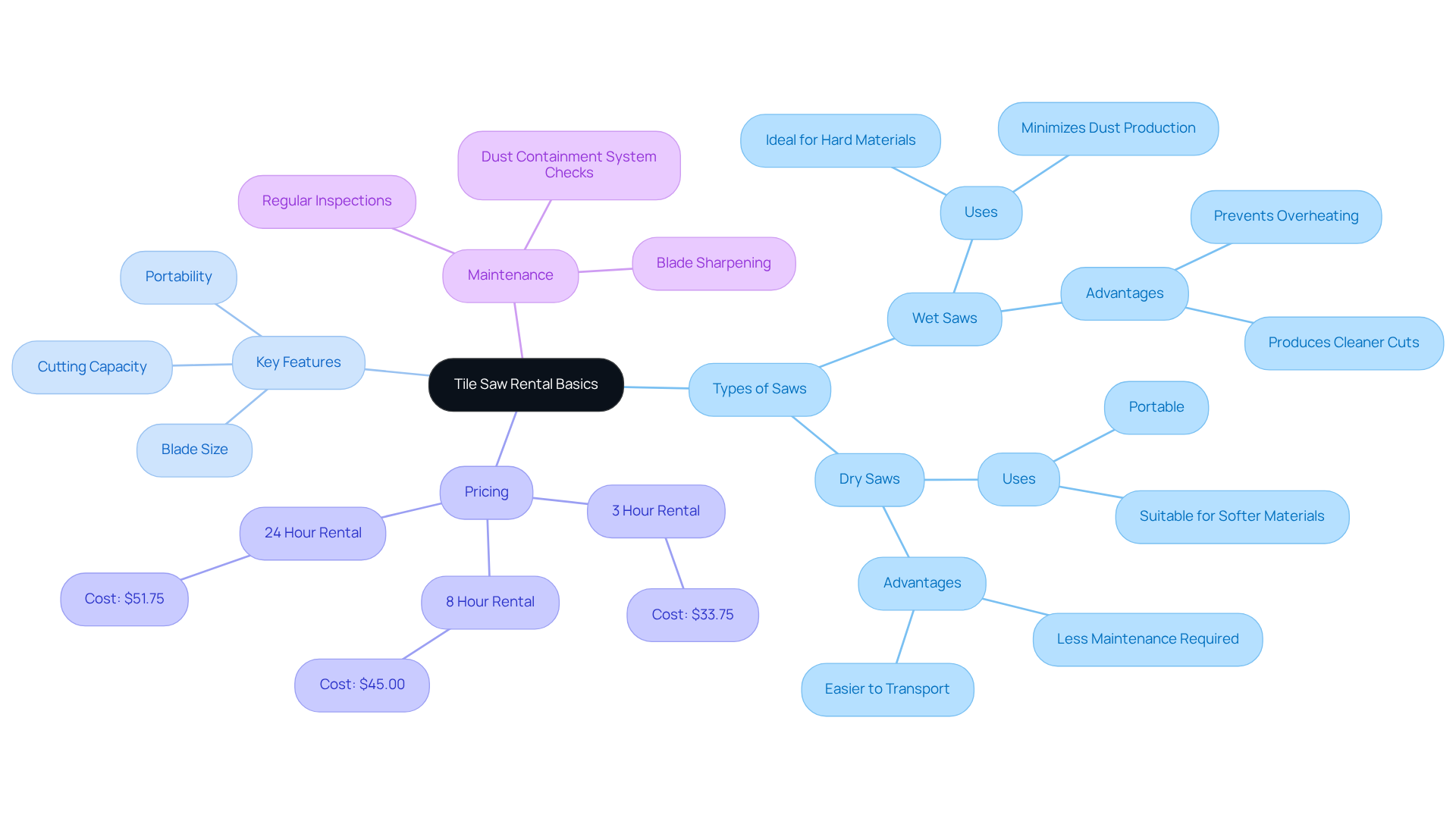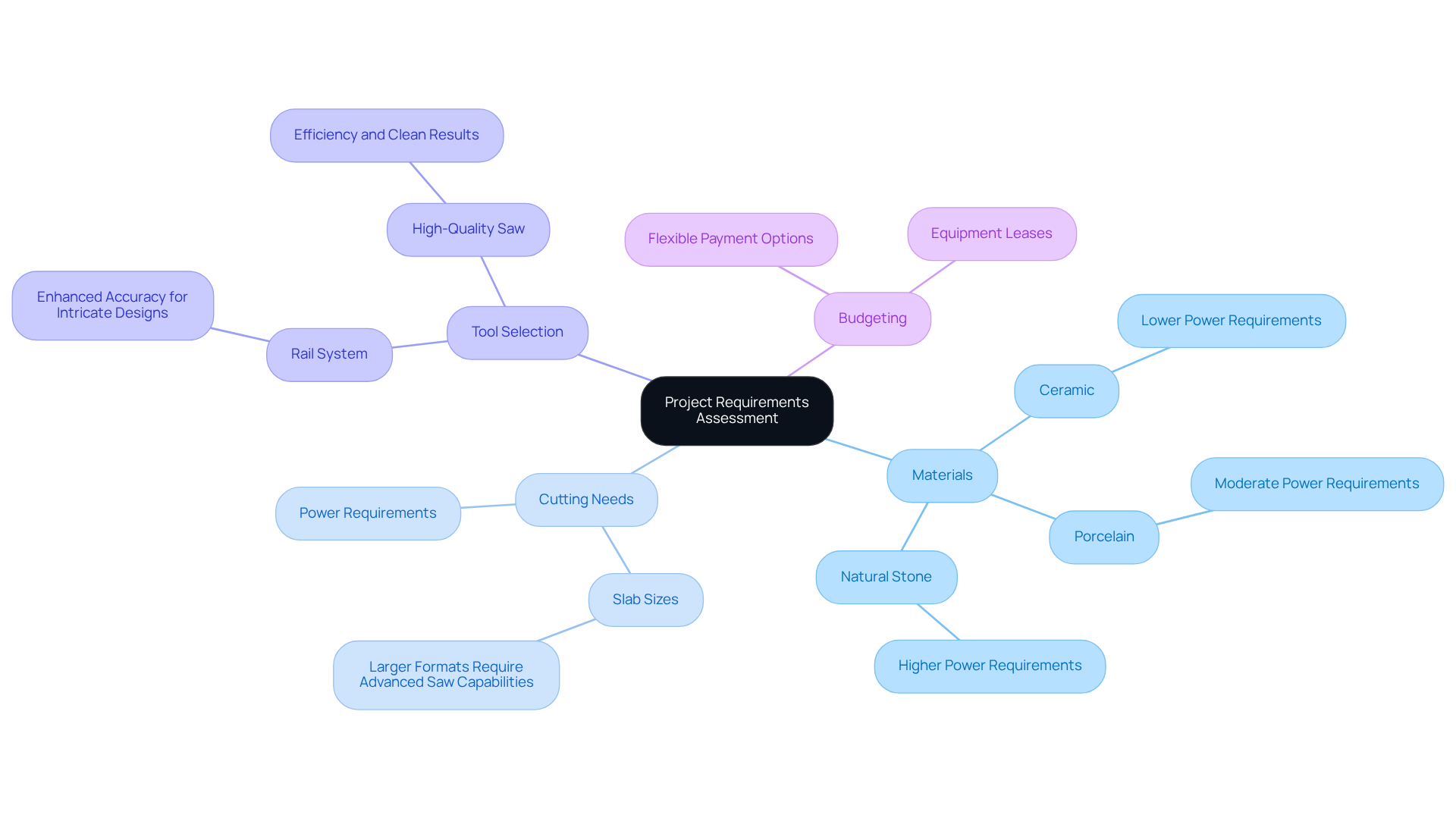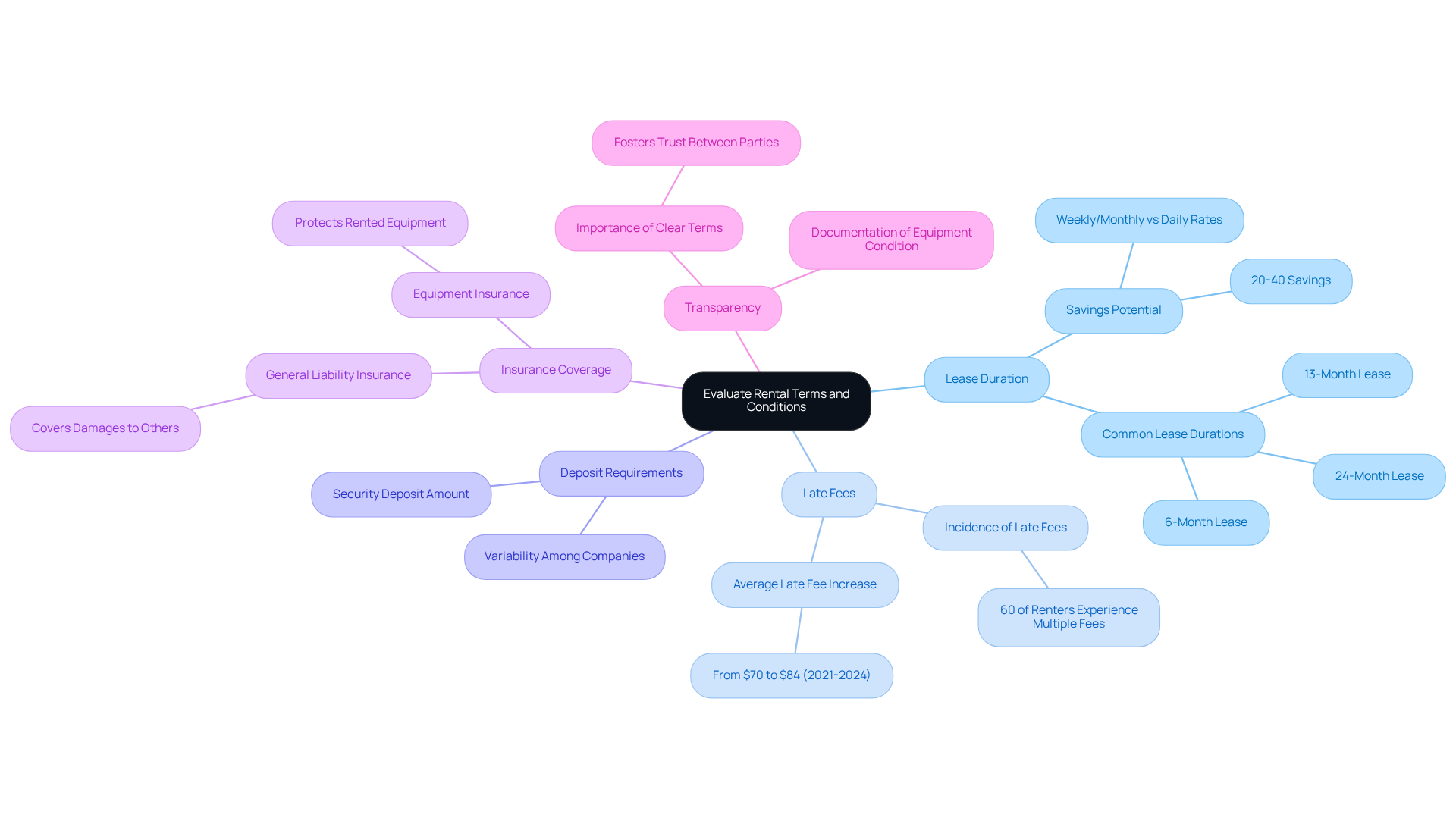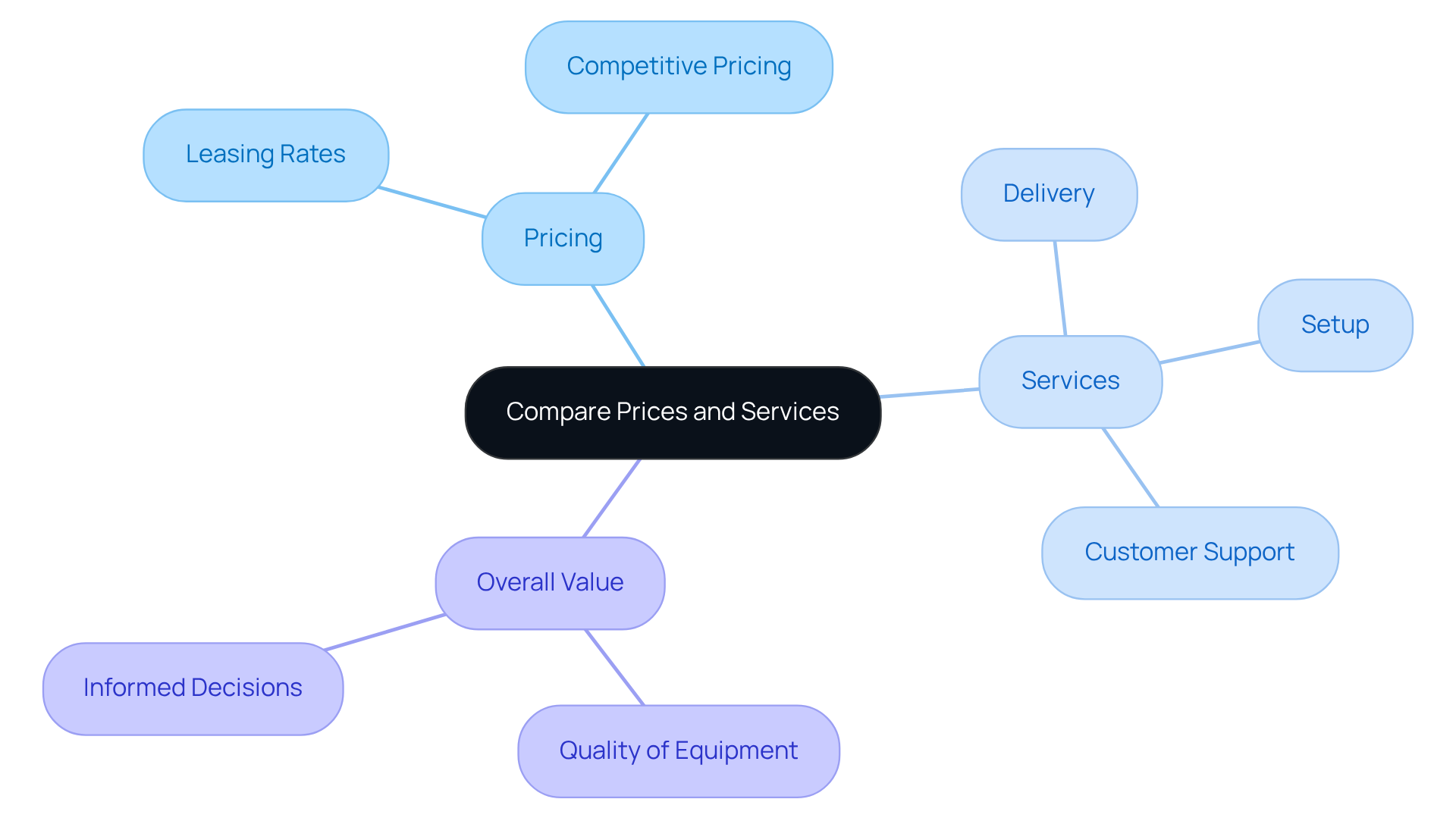Overview
To rent a tile saw effectively, project managers must first assess their specific cutting needs. Understanding the types of saws available and the local rental options is crucial. By researching local rental companies, managers can find the best value and equipment suitability for their projects. Furthermore, carefully evaluating rental terms ensures that the chosen equipment aligns with both project requirements and budget constraints.
This article provides detailed insights on various types of saws, including pricing in Texas, which is essential for informed decision-making. Key factors such as maintenance and service quality are also discussed, enabling managers to select equipment that meets their reliability and quality standards. For example, testimonials from satisfied customers highlight the effectiveness of specific tools, reinforcing their value in project execution.
In conclusion, project managers are encouraged to take action by exploring rental options that fit their needs. By following the guidelines outlined in this article, they can make informed choices that enhance their project's success while adhering to budget constraints.
Key Highlights:
- Tile saws are essential for precise cutting of flooring materials, available in wet and dry types.
- Wet saws use water to cool the blade, reducing dust and preventing overheating, ideal for hard materials like porcelain and glass.
- Dry saws are portable and suited for softer materials but may wear blades faster due to friction.
- Key features to consider include blade size, cutting capacity, and portability.
- Rental prices in Texas range from $33.75 for a 3-hour rental to $51.75 for a full day.
- Wet saws reduce dust and prevent chipping, ensuring smoother cuts; regular maintenance is crucial for performance.
- Project requirements should be assessed based on the material type, cutting needs, and complexity of designs.
- Research local rental companies for reliability and customer service, using platforms like Google Maps or Yelp.
- Evaluate rental agreements carefully, focusing on lease duration, late fees, deposit requirements, and insurance coverage.
- Comparing prices and services is essential; consider overall value rather than just the lowest price.
Introduction
Navigating the world of tile saw rentals can be a daunting task for project managers, particularly when precision and efficiency are paramount. With a variety of saws available and numerous rental companies to choose from, understanding the nuances of each option is essential for successful project execution.
Key factors to consider include:
- The type of saw
- Rental terms
- The specific needs of your project
This guide aims to demystify tile saw rentals, offering a step-by-step approach that empowers project managers to make informed decisions that align with their unique requirements and budgets.
Understand Tile Saw Rental Basics
Understanding where to rent a tile saw is crucial before making a rental decision. These specialized instruments are crafted for precise cutting of flooring materials and come in two primary types: wet and dry. Wet cutting tools utilize a diamond blade cooled by water, which not only prevents overheating but also minimizes dust production, making them ideal for cutting tough materials such as porcelain and glass. Conversely, dry saws are typically more portable and suited for softer materials, though they may experience increased blade wear due to excessive friction.
Key features to consider include blade size, cutting capacity, and the saw's portability. For example, the iQTS244 wet saw is renowned for its integrated dust containment system, which enhances job site cleanliness and reduces cleanup time. Furthermore, it boasts a comprehensive dry system that effectively traps particulate matter, further improving the workspace environment. As Bryant Figueroa aptly states, "A cutting saw might not be the first tool you consider when enhancing your workspace, but its versatility and accuracy make it an essential resource." Nick Rascona adds, "Select a wet saw cutter if you are working on large flooring tasks, need to cut hard and glass surfaces, make straight, curved, and miter cuts, and require a tool that can operate swiftly."
In Texas, pricing for tile cutting machines varies, and if you're looking for where to rent a tile saw, fees typically range from $33.75 for a 3-hour rental to $51.75 for a full day. This pricing structure allows managers to choose a rental period that aligns with their project timelines and budget constraints.
Case studies highlight the effectiveness of wet saws in construction projects. For instance, utilizing a wet saw significantly reduces dust production, which is vital for maintaining a clean workspace and ensuring safety. Additionally, the cooling effect of water helps prevent chipping and cracking, resulting in smoother, cleaner cuts. Regular maintenance, including blade sharpening and dust system inspections, is essential for optimal performance and longevity of the saw. Neglecting these maintenance practices can lead to functionality issues, impacting the quality of cuts and overall efficiency.
By familiarizing yourself with these features of ceramic saws, you can make an informed choice that enhances the effectiveness and quality of your cutting tasks.

Assess Your Project Requirements
To effectively evaluate your assignment needs, it is crucial to recognize the specific categories of materials you will be cutting—ceramic, porcelain, or natural stone. Each material presents distinct cutting requirements; for instance, ceramic surfaces generally necessitate less power compared to denser substances like granite or engineered stone. The ongoing labor shortage in the ceramics sector poses challenges that could impact timelines and resource availability. Therefore, measuring the average dimensions of the slabs is essential, as larger formats may require advanced saw capabilities for precision cuts.
If your project includes intricate designs or complex patterns, consider utilizing a saw equipped with features such as a rail system for enhanced accuracy. Additionally, assess the quantity of tiles to be cut, as this will influence both the duration of use and the power requirements of the saw. Managers often find that investing in a high-quality saw not only enhances efficiency but also guarantees clean, professional results—vital for upholding timelines and budgets.
Moreover, with competitive pricing and flexible payment options available, project managers can effectively budget their equipment leases while addressing the growing demand for adaptability features in residential renovations. By prioritizing the right tools and equipment, you position your project for success, ensuring that you meet both quality standards and client expectations.

Research Local Rental Companies
Initiate your search by identifying equipment leasing companies in your vicinity, especially those that can advise you on where to rent a tile saw. In Irving, TX, EZ Equipment Rental stands out with its extensive selection of equipment, including boom lifts, excavators, and forklifts, catering to the entire DFW Metroplex.
Leverage online platforms, such as Google Maps or Yelp, to access customer reviews and ratings for these companies. Prioritize those with a robust reputation for reliability and exceptional customer service, exemplified by EZ Equipment Rental, recognized for its accessibility and support throughout the Dallas-Fort Worth area.
Additionally, consider reaching out to colleagues or industry contacts for their recommendations. Compile a list of potential leasing companies to evaluate their offerings effectively.
Evaluate Rental Terms and Conditions
After narrowing down your options for leasing companies, it is crucial to meticulously examine their agreements. Pay close attention to the specifics regarding lease duration, as this can significantly impact your project timeline and budget. For example, statistics indicate that selecting weekly or monthly agreements can save you 20-40% compared to daily prices, making the choice of duration essential.
Additionally, be aware of late fees, which can escalate quickly. Nearly 60% of renters who incur a late fee experience multiple fees within a year, with the average late fee rising from over $70 in September 2021 to $84 by November 2024. Understanding the deposit requirements is also essential, as the lease agreement must clearly state the amount of the security deposit, which can vary significantly among leasing companies.
Insurance coverage is another critical aspect to consider. Ensure that the agreement clearly outlines who is responsible for equipment maintenance and damage liability. General Liability Insurance covers damages to others, including injuries or property damage. Some leasing firms may offer maintenance services, while others may inform you where to rent a tile saw and require you to return it in its original condition.
As legal specialists highlight, "Transparency in the terms and conditions of equipment leasing agreements is essential for fostering trust between parties." By addressing these elements upfront, including documenting the condition of the equipment upon receipt, you can avoid misunderstandings and ensure a smoother borrowing experience.

Compare Prices and Services
When evaluating options on where to rent a tile saw, it is crucial to gather comprehensive information on terms and pricing from various companies. EZ Equipment Rental in Dallas offers competitive pricing options, making quality equipment, including forklifts, accessible and affordable for businesses of all sizes. Not only should you compare leasing rates, but also the included services, such as delivery, setup, and customer support. EZ Equipment Rental is committed to providing outstanding service, ensuring you receive reliable equipment tailored to your needs.
Consider the overall value instead of solely focusing on the lowest price; a slightly higher rental fee may come with superior service or more dependable equipment. When considering where to rent a tile saw, make informed decisions based on a combination of cost, service quality, and the specific requirements of your project. By prioritizing these factors, you can ensure that your equipment rental experience is both efficient and effective.

Conclusion
Understanding the intricacies of tile saw rentals is essential for project managers aiming to enhance the precision and efficiency of their cutting tasks. By recognizing the various types of tile saws, evaluating project requirements, and researching local rental options, managers can make informed decisions that align with their specific needs. This comprehensive guide underscores the importance of selecting the right equipment, as this choice can significantly impact project outcomes.
Key insights from this guide highlight the differences between wet and dry tile saws, the necessity of assessing material types, and the significance of comparing rental terms and prices. Furthermore, understanding maintenance and the value of customer service can lead to a more successful rental experience. By prioritizing these factors, project managers can ensure that their cutting tasks are executed smoothly and professionally.
Ultimately, the decision on where to rent a tile saw should be approached with careful consideration and thorough research. By leveraging local resources, evaluating rental agreements, and focusing on overall value rather than just cost, project managers can set their projects up for success. Engaging with reputable rental companies and understanding the nuances of equipment leasing not only fosters trust but also enhances the likelihood of achieving high-quality results.
Frequently Asked Questions
What are the two primary types of tile saws available for rental?
The two primary types of tile saws are wet saws and dry saws. Wet saws use a diamond blade cooled by water, while dry saws are typically more portable and suited for softer materials.
What are the advantages of using a wet saw?
Wet saws prevent overheating, minimize dust production, reduce chipping and cracking, and provide smoother, cleaner cuts, making them ideal for tough materials like porcelain and glass.
What should I consider when renting a tile saw?
Key features to consider include blade size, cutting capacity, portability, and the specific material you'll be cutting. It's also important to assess the project's requirements and the quantity of tiles to be cut.
How much does it typically cost to rent a tile saw in Texas?
Rental fees for tile saws in Texas generally range from $33.75 for a 3-hour rental to $51.75 for a full day.
Why is regular maintenance important for tile saws?
Regular maintenance, including blade sharpening and dust system inspections, is essential for optimal performance and longevity. Neglecting maintenance can lead to functionality issues, impacting the quality of cuts and overall efficiency.
How do different materials affect tile cutting requirements?
Different materials present distinct cutting requirements; for example, ceramic surfaces require less power than denser substances like granite or engineered stone.
What features should I look for in a saw if my project involves intricate designs?
If your project includes intricate designs or complex patterns, consider utilizing a saw equipped with features such as a rail system for enhanced accuracy.
How can investing in a high-quality saw benefit my project?
Investing in a high-quality saw enhances efficiency and guarantees clean, professional results, which are essential for meeting timelines and budgets in construction projects.




